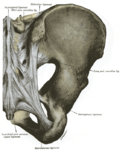Pudendal nerve
Pudendal Nerve
The Pudendal Nerve is a major nerve in the pelvis that supplies areas of the lower body including the anus, perineum, and genitalia. It is derived from the sacral plexus, specifically the S2, S3, and S4 nerves.
Anatomy
The pudendal nerve originates from the sacral plexus, which is a network of nerves in the pelvis. It then travels through the Alcock's canal, a pathway in the pelvis, before branching off to supply various areas of the lower body.
Branches
The pudendal nerve has three main branches:
- Inferior rectal nerve: This branch supplies the anus and the skin around it.
- Perineal nerve: This branch supplies the perineum, the area between the anus and the genitals.
- Dorsal nerve of the penis or clitoris: This branch supplies the penis in males and the clitoris in females.
Function
The pudendal nerve has both sensory and motor functions. It provides sensation to the genitals, the skin around the anus, and the perineum. It also controls the muscles that help in urination and defecation.
Clinical significance
Damage to the pudendal nerve can lead to a variety of conditions, including pudendal neuralgia, a type of chronic pelvic pain. Other conditions that can result from pudendal nerve damage include sexual dysfunction, urinary incontinence, and fecal incontinence.
See also
References
Transform your life with W8MD's budget GLP-1 injections from $125.
W8MD offers a medical weight loss program to lose weight in Philadelphia. Our physician-supervised medical weight loss provides:
- Most insurances accepted or discounted self-pay rates. We will obtain insurance prior authorizations if needed.
- Generic GLP1 weight loss injections from $125 for the starting dose.
- Also offer prescription weight loss medications including Phentermine, Qsymia, Diethylpropion, Contrave etc.
NYC weight loss doctor appointments
Start your NYC weight loss journey today at our NYC medical weight loss and Philadelphia medical weight loss clinics.
- Call 718-946-5500 to lose weight in NYC or for medical weight loss in Philadelphia 215-676-2334.
- Tags:NYC medical weight loss, Philadelphia lose weight Zepbound NYC, Budget GLP1 weight loss injections, Wegovy Philadelphia, Wegovy NYC, Philadelphia medical weight loss, Brookly weight loss and Wegovy NYC
|
WikiMD's Wellness Encyclopedia |
| Let Food Be Thy Medicine Medicine Thy Food - Hippocrates |
Medical Disclaimer: WikiMD is not a substitute for professional medical advice. The information on WikiMD is provided as an information resource only, may be incorrect, outdated or misleading, and is not to be used or relied on for any diagnostic or treatment purposes. Please consult your health care provider before making any healthcare decisions or for guidance about a specific medical condition. WikiMD expressly disclaims responsibility, and shall have no liability, for any damages, loss, injury, or liability whatsoever suffered as a result of your reliance on the information contained in this site. By visiting this site you agree to the foregoing terms and conditions, which may from time to time be changed or supplemented by WikiMD. If you do not agree to the foregoing terms and conditions, you should not enter or use this site. See full disclaimer.
Credits:Most images are courtesy of Wikimedia commons, and templates, categories Wikipedia, licensed under CC BY SA or similar.
Contributors: Prab R. Tumpati, MD








